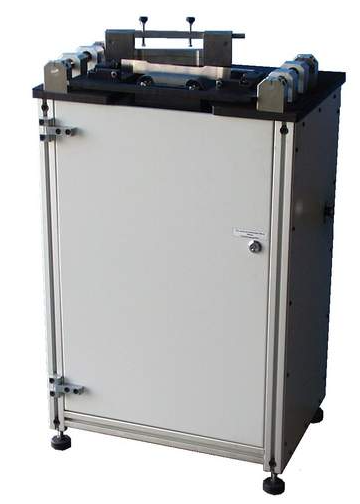PSM 2000
 The basic requirement for obtaining correct results from tensile tests on sheet metal is the specimen itself, correct dimensions, finished surface at the edges and correct preparation in general without affecting the mechanical properties of the tensile specimen. Punching is the most effective and economical method of specimen preparation when it is possible to quickly and effectively remove the work-hardened zone / edge damage from the specimen. The PSM 2000 sheet metal tensile testing machine (well known since 1970) has been redesigned to meet this requirement perfectly and quickly. The machine is so easy to use that even an unskilled worker can produce high quality specimens after a few minutes training. The specimens are perfectly parallel in gauge length (within 0.02mm parallelism). The grinding process takes less than 2 or 3 minutes (depending on the type of specimen). The quality meets and complies with the requirements of all testing standards (ISO 6892-1 / ASTM E370, JIS ...) and the IDDRG (International Deep Drawing Research Group). The machine is under continuous improvement and we are currently building the fifth generation. The grinding belt is tensioned by a pneumatic system. This increases the comfort and also the reliability of the grinding parallelism. PSM2000 the synonym for highest quality in tensile specimen preparation. Suitable for blanked specimens and also for specimens cut by laser, water jet, milling and others. The machine is equipped with an industrial quality abrasive belt of 2000 mm length. The grinding speed of the belt corresponds to the speed required for the grinding process on metal (15 metres per second) and has a large surface for the grinding consumables (surface 2000 mm in length x 100 mm in width = 200,000 mm²). For special requirements, we are able to supply special abrasive belts with cooling function or for special materials such as titanium, stainless steel, carbon steel and more. Some of our customers also use aluminium oxide abrasive paper to enable this machine to be used for sample grinding for spectral analysis (so as not to contaminate the metal with carbon from the SiC paper).
The basic requirement for obtaining correct results from tensile tests on sheet metal is the specimen itself, correct dimensions, finished surface at the edges and correct preparation in general without affecting the mechanical properties of the tensile specimen. Punching is the most effective and economical method of specimen preparation when it is possible to quickly and effectively remove the work-hardened zone / edge damage from the specimen. The PSM 2000 sheet metal tensile testing machine (well known since 1970) has been redesigned to meet this requirement perfectly and quickly. The machine is so easy to use that even an unskilled worker can produce high quality specimens after a few minutes training. The specimens are perfectly parallel in gauge length (within 0.02mm parallelism). The grinding process takes less than 2 or 3 minutes (depending on the type of specimen). The quality meets and complies with the requirements of all testing standards (ISO 6892-1 / ASTM E370, JIS ...) and the IDDRG (International Deep Drawing Research Group). The machine is under continuous improvement and we are currently building the fifth generation. The grinding belt is tensioned by a pneumatic system. This increases the comfort and also the reliability of the grinding parallelism. PSM2000 the synonym for highest quality in tensile specimen preparation. Suitable for blanked specimens and also for specimens cut by laser, water jet, milling and others. The machine is equipped with an industrial quality abrasive belt of 2000 mm length. The grinding speed of the belt corresponds to the speed required for the grinding process on metal (15 metres per second) and has a large surface for the grinding consumables (surface 2000 mm in length x 100 mm in width = 200,000 mm²). For special requirements, we are able to supply special abrasive belts with cooling function or for special materials such as titanium, stainless steel, carbon steel and more. Some of our customers also use aluminium oxide abrasive paper to enable this machine to be used for sample grinding for spectral analysis (so as not to contaminate the metal with carbon from the SiC paper).


